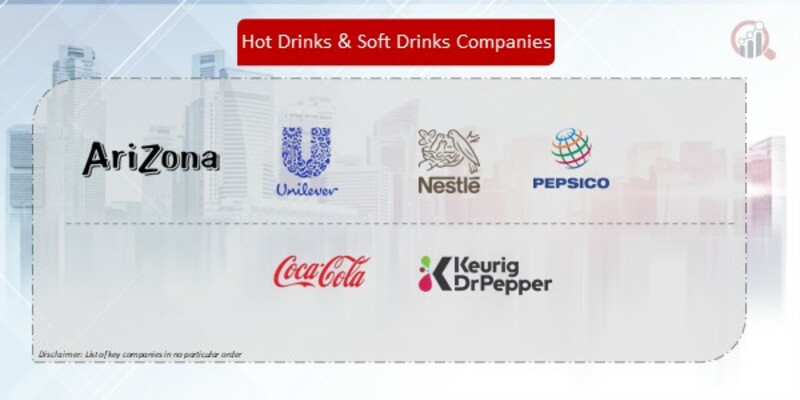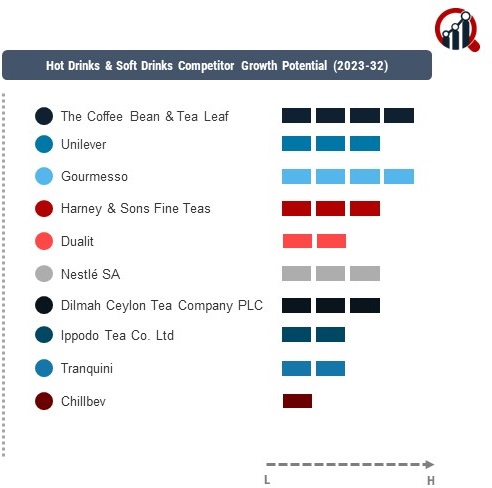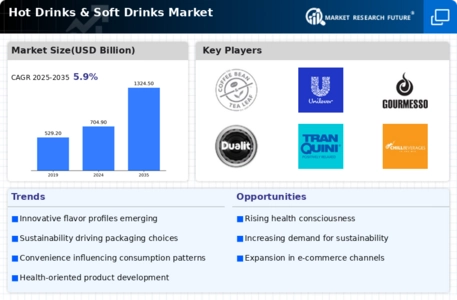Top Industry Leaders in the Hot Drinks & Soft Drinks Market
 The competitive landscape of the hot drinks and soft drinks market is shaped by key players employing various strategies to navigate the diverse and ever-evolving beverage industry. As of 2023, major players have solidified their positions, focusing on product innovation, sustainability, and strategic partnerships to maintain a competitive edge in this dynamic market.
The competitive landscape of the hot drinks and soft drinks market is shaped by key players employing various strategies to navigate the diverse and ever-evolving beverage industry. As of 2023, major players have solidified their positions, focusing on product innovation, sustainability, and strategic partnerships to maintain a competitive edge in this dynamic market.
Key Players:
The Coffee Bean & Tea Leaf (U.S)
Unilever (U.K)
Gourmesso (U.S)
Harney & Sons Fine Teas (U.S)
Dualit (U.K)
Nestlé SA (Switzerland)
Dilmah Ceylon Tea Company PLC (Sri Lanka)
Ippodo Tea Co. Ltd. (China)
Tranquini (U.S)
Chillbev (U.S)
Som Sleep.(U.S)
Phi Drinks, Inc. (U.S)
BevNet.com (U.S)
Pepsico, Inc.
The Coca-Cola Company
Keurig Dr Pepper Inc (KDP)
Red Bull GmbH
Monster Energy Company
Appalachian Brewing Company
ITO EN INC.
AriZona Beverages USA LLC
Strategies Adopted:
Strategies adopted by these key players revolve around brand management, diversification, and sustainability. The Coca-Cola Company and PepsiCo leverage their extensive brand portfolios, investing heavily in marketing and promotion to maintain brand loyalty and market share. Nestlé S.A. focuses on diversification, offering a broad range of hot and soft drinks to cater to diverse consumer preferences. Keurig Dr Pepper Inc. embraces both hot and soft drink markets, seeking growth through strategic acquisitions to expand its product range. Unilever emphasizes sustainability in its beverage portfolio, with a commitment to sourcing responsibly and reducing its environmental impact.
Market Share Analysis:
The hot drinks and soft drinks market is influenced by factors such as brand recognition, distribution networks, pricing strategies, and responsiveness to consumer trends. Companies that effectively adapt their product offerings to changing consumer preferences, maintain competitive pricing, and secure prominent shelf space tend to secure a larger market share. Additionally, strategic collaborations with retailers, quick-service restaurants, and e-commerce platforms contribute significantly to market penetration.
News & Emerging Companies:
The hot drinks and soft drinks market have gained attention in 2023, introducing innovations such as functional beverages, natural ingredients, and sustainable packaging. These companies contribute to the market's diversification by addressing evolving consumer demands for healthier and eco-friendly beverage options. While their market share may be relatively modest compared to industry giants, their agility and ability to respond to emerging trends play a crucial role in shaping the overall market landscape.
Industry Trends:
Industry trends highlight the growing emphasis on sustainability and health-conscious offerings within the hot drinks and soft drinks market. Companies are investing in research and development to create healthier formulations, reduce sugar content, and introduce eco-friendly packaging. Additionally, there is a notable trend toward incorporating functional ingredients, such as botanical extracts and vitamins, in both hot and soft drinks. This reflects the industry's commitment to meeting consumer expectations for healthier beverage options.
Competitive Scenario:
The hot drinks and soft drinks market reflects a balance between established players with global reach and emerging disruptors offering innovative solutions. Key players maintain their market leadership through brand strength, diversified product portfolios, and strategic investments in sustainability and health-conscious formulations. Emerging companies contribute to the market's dynamism with a focus on niche markets, functional beverages, and responsiveness to evolving consumer preferences. The competition is further intensified by the entry of startups, technological advancements, and the industry's response to changing consumer expectations.
Recent Development
The hot drinks and soft drinks market expanding their efforts to reduce plastic waste. Some key players have announced initiatives to invest in sustainable packaging solutions, including the use of recycled materials and the development of biodegradable options. This development aligns with the industry's recognition of the environmental impact of packaging and reflects a commitment to addressing sustainability concerns.










